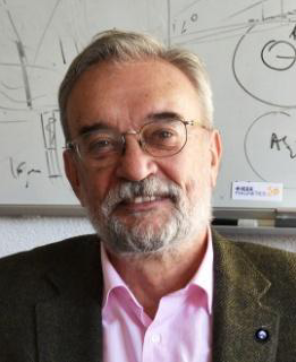GENERAL SEMINAR: Manuel Vazquez-IEEE Magnetics Society Distinguished Lecturer 2023, Institute of Materials Science of Madrid, Spanish Research Council
IEEE Magnetics Society Distinguished Lecturer 2023
Cylindrical Micro- and Nanowires: From Curvature Effects on Magnetization to Sensing Applications
Manuel Vázquez
Institute of Materials Science of Madrid, Consejo Superior de Investigaciones Científicas, Spain
Research on curvature effects in magnetic nanostructures is attracting much interest as they offer novel alternatives
to planar systems. In particular, the cylindrical geometry introduces significant singularities in the magnetic
response of ferromagnetic wires just from their curvature, which primarily depends on their diameter, length, and
aspect ratio. The main magnetic configurations include axial, transverse, and vortex (circular with a singularity at
the axis). Microwires, 1 to 200 micrometer diameter, are fabricated by in-rotating-water and by quenching and
drawing ultrarapid solidification techniques. Amorphous wires with high magnetostriction re-magnetize through an
ideal millimeter-long single domain wall propagating at kilometer-per-second speeds that results in a square
hysteresis loop. Such bistable behavior and their magnetoelastic properties are the basis for various devices (e.g.,
field, stress and temperature sensors, electromagnetic shielding). On the other hand, ultrasoft non-magnetostrictive
microwires are employed in very sensitive field sensors based on their Giant Magneto-Impedance, GMI, effect or in
flux-gate magnetometers.
Nanowires (20 nm to 400 nm diameter) present an outstanding behavior where the crystalline structure plays a major
role in competition with shape anisotropy. Cylindrical nanowires are considered as scaffolds for advanced 3D
nanoarchitectures exploiting intrinsic curvature that introduces significant differences from planar-based
nanotechnologies. They are proposed for novel sensor devices and magnets, and their interconnecting arrays are
considered for energy devices or brain-inspired computing. An ultimate goal is currently the investigation of the
magnetization reversal modes in individual nanowires by advanced techniques, e.g., X-ray magnetic circular
dichroism (XMCD) coupled to photoemission electron microscopy (PEEM), magnetic force microscopy (MFM),
magneto-optical Kerr effect (MOKE), electron holography, and micromagnetic simulations. They show axial,
transverse, vortex, and more complex, exotic magnetic configurations and effects (e.g., magnetization ratchet,
skyrmion tubes, helical vortices). The reversal nucleates at the nanowire ends, involving singularities (e.g., Bloch-
point walls) and at local transition regions (e.g., modulations in diameter or composition between segments of
differently designed magnetic properties). Individual nanowires are currently used or proposed for biomedical
applications, such as cancer treatment, magnetic resonance imaging (MRI) contrast agents, or in composites for their
antimicrobial activity.
 Manuel Vázquez has been a Professor of Research in the Spanish Council for Research
Manuel Vázquez has been a Professor of Research in the Spanish Council for Research
(CSIC) since 1996. He was responsible of many scientific and technological projects on
the magnetism of nano- and microwires, and has supervised 35 Ph.D. students and
numerous visiting scientists. He is coauthor of over 600 publications (H index = 65,
18000 citations) and 23 patents, and has contributed to several books, including as editor
of Magnetic Nano- and Microwires (Elsevier, 2015 and 2020). After defending his Ph.D.
at the Complutense University of Madrid, he was an Alexander von Humboldt
postdoctoral fellow at the Max-Planck-Institute für Metallforschung, Stuttgart, and at the
Technical University of Denmark, Lyngby, under a NATO research grant. He was the
Head of Laboratory at the Institute of Applied Magnetism, IMA (1992-2000) and
Manager of the Spanish Strategic Action on Nanoscience and Nanotechnology (2004-
2009). He established the Group of Nanomagnetism and Magnetization Processes at ICMM/CSIC (2001). Prof.
Vázquez has actively volunteered in international activities, particularly those of the IEEE Magnetics Society: He
founded the society’s Spain Chapter in 2007, was chair of the Intermag Conference in 2008, and served as President
in 2017-2018. He received the society’s Distinguished Service Award in 2021. For the International Union of Pure
and Applied Physics (IUPAP), he served as Secretary of the Magnetism Commission and as Program Chair of the
International Conference on Magnetism (ICM) in 2015. He was co-founder of the Club Español de Magnetismo in
2002 and received its Salvador Velayos Award in 2016. Contact details: mvazquez@icmm.csic.es.